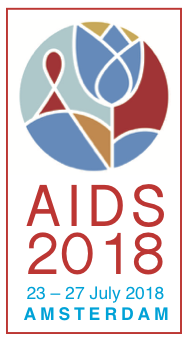WHO recommends dolutegravir widely but women’s access will depend on contraception provision (2018)
3 August 2018. Related: Conference reports, Women's health, Pregnancy, Guidelines, World AIDS 22 Amsterdam 2018.
Polly Clayden, HIV i-Base
 WHO launched new interim guidance on HIV treatment at AIDS 2018 recommending dolutegravir (DTG) for everyone aged six years and above. [1, 2] But access to DTG for women and adolescent girls of child bearing potential will depend on the availability of consistent and reliable contraception and how countries decide to interpret this.
WHO launched new interim guidance on HIV treatment at AIDS 2018 recommending dolutegravir (DTG) for everyone aged six years and above. [1, 2] But access to DTG for women and adolescent girls of child bearing potential will depend on the availability of consistent and reliable contraception and how countries decide to interpret this.
The 2016 WHO consolidated guidelines recommended tenofovir/lamivudine or emtricitabine/efavirenz 600 mg (TDF/3TC or FTC [XTC] EFV 600 mg) as preferred adult and adolescent first-line ART regimen. [3]
Dolutegravir (DTG)-based first-line ART was recommended as an alternative regimen due to evidence gaps for its use in pregnancy, preconception and with rifampicin (RIF)-based tuberculosis (TB) treatment and lack of generic formulations at that time.
Use of dolutegravir
WHO has recently updated its ART systematic review and meta-analysis (not yet published in full). This review confirmed the 2016 review findings, showing a regimen with two nucleoside reverse-transcriptase inhibitors (NRTIs) plus DTG to be more effective, with better viral suppression, CD4 count recovery and lower risk of treatment discontinuation compared with EFV-based ART in treatment-naive adults.
DTG has other advantages compared with EFV, including fewer drug-drug interactions, faster viral suppression and a higher genetic barrier to developing resistance. Unlike EFV, DTG is also effective against HIV-2.
But, there are safety concerns with women and adolescent girls using DTG at conception. Although starting DTG in pregnancy appears to be safe. For women and adolescent girls of childbearing potential who do not wish to become pregnant, and are fully informed of the benefits and risks, DTG is recommended with consistent contraception. DTG and hormonal contraception do not have documented or expected drug-drug interactions. This is based on limited data but is not at all likely.
WHO recommends women and adolescent girls of child-bearing potential receive EFV or protease inhibitor (PI)-based regimens if consistent and reliable contraception cannot be assured or if a woman wishes to become pregnant.
WHO also recommends DTG for children six years and above and notes that raltegravir (RAL) could be an effective integrase inhibitor for younger children for whom dosing information is not yet available.
WHO also recommends that countries with pre-treatment resistance to EFV or nevirapine (NVP) at 10% or above should urgently consider using an alternative regimen that does not contain non-nucleoside reverse- transcriptase inhibitors (NNRTIs). DTG with consistent and reliable contraception for women and adolescent girls or atazanavir/ritonavir (ATV/r) are suitable options.
Second-line
WHO recommends DTG for people who have failed an NNRTI or protease inhibitor (PI)-based first-line, with the same preconception safety caveats for women. PI-based treatment with an ATV/r or lopinavir/ritonavir (LPV/r)-based regimen is recommended for people who receive DTG first-line.
An optimised NRTI backbone should be used for second-line, such as zidovudine (AZT) following TDF or abacavir (ABC) failure and vice versa.
Table 1. Summary of options for first-, second- and third-line ART regimens for adults (including pregnant women and adolescents) and children
| Population | First-line | Second-line | Third-line |
| Adults and adolescents (including women and adolescent girls of child bearing potential or pregnant) | 2 NRTIs + DTG | 2 NRTIs + ATV/r or LPV/r | DRV/r + DTG + 1–2 NRTIs (consider genotyping if possible) |
| 2 NRTIs + EFV | 2 NRTIs + DTG | ||
| Children | 2 NRTIs + DTG | 2 NRTIs + ATV/r or LPV/r | |
| 2 NRTIs + LPV/r | 2 NRTIs + DTG | ||
| 2 NRTIs + NNRTIs | 2 NRTIs + DTG |
Key: ATV/r, atazanavir/ritonavir; DTG, dolutegravir; DRV/r, darunavir/ritonavir; EFV, efavirenz; LPV/r, lopinavir/r;
NNRTI, non-nucleoside reverse transcriptase inhibitor; NRTI, nucleos/tide reverse transcriptase inhibitor
comment
Women with HIV attending AIDS 2018 quite rightly made it abundantly clear that they must: have access to DTG, be consulted as policies and guidelines are developed, be given information and be provided with contraception and choice.
If the DTG signal can lead to improvement of sexual and reproductive health services for HIV positive women, in settings where this is shockingly inadequate, that would be something good to have come out of this unfortunate situation.
References
- WHO. What’s new in WHO Treatment guidelines: the role of DTG in first- and second-line and new directions in early infant diagnosis. Session MOSA26.
http://programme.aids2018.org/Programme/Session/1508 - WHO policy brief. Antiretroviral regimens for treating and preventing HIV infection and update on early infant diagnosis of HIV. July 2018.
http://apps.who.int/iris/bitstream/handle/10665/273129/WHO-CDS-HIV-18.19-eng.pdf (PDF) - WHO. Consolidated guidelines on the use of antiretroviral drugs for treating and preventing HIV infection. Recommendations for a public health approach – Second edition. June 2016.
http://www.who.int/hiv/pub/arv/arv-2016/en/

